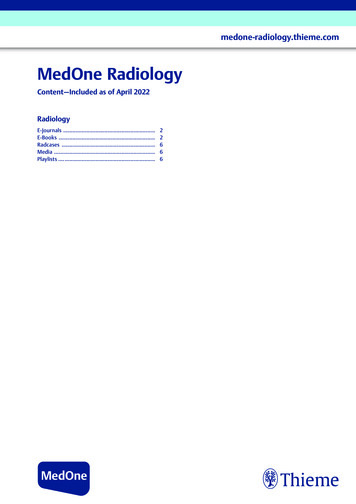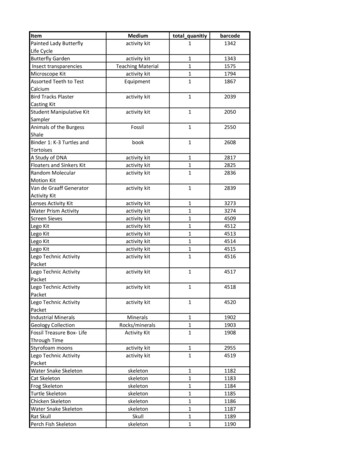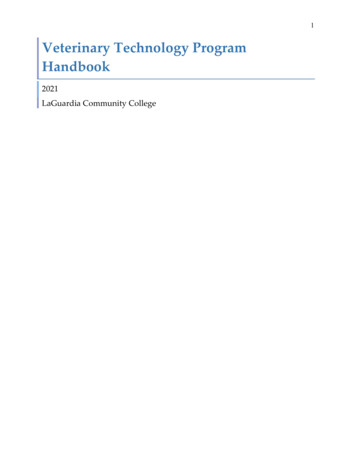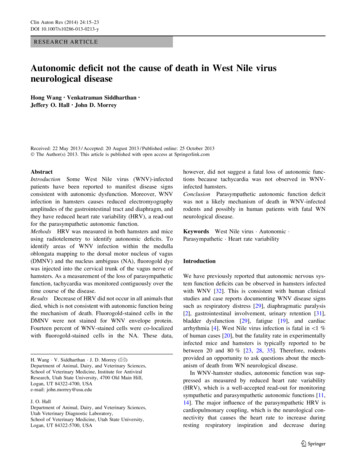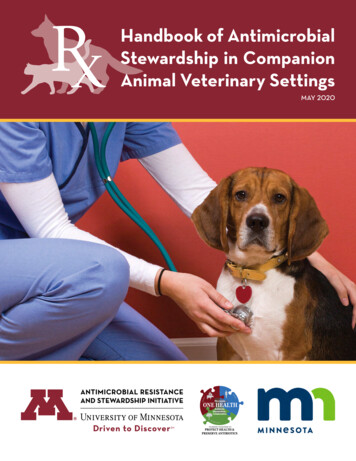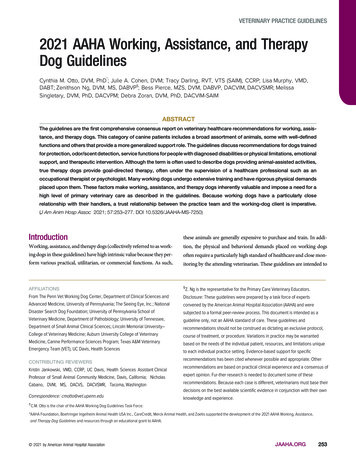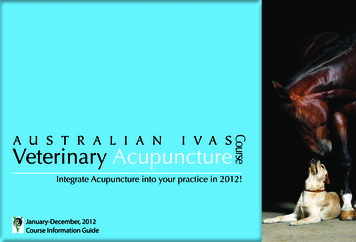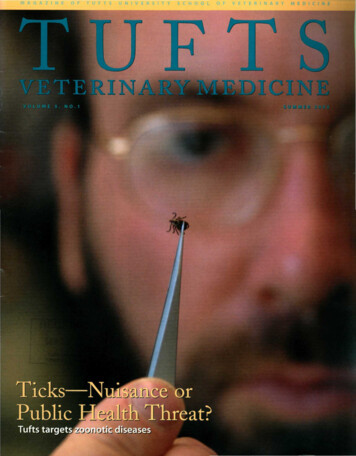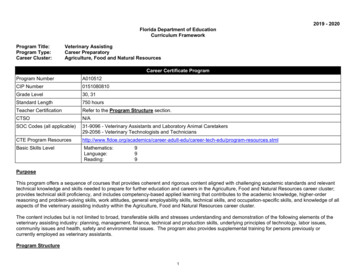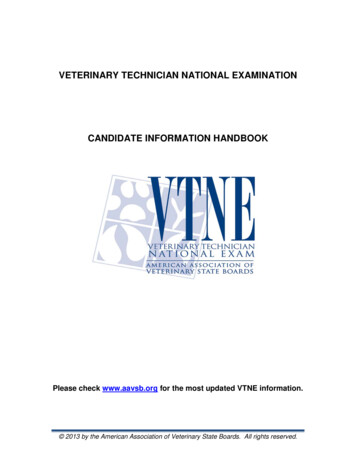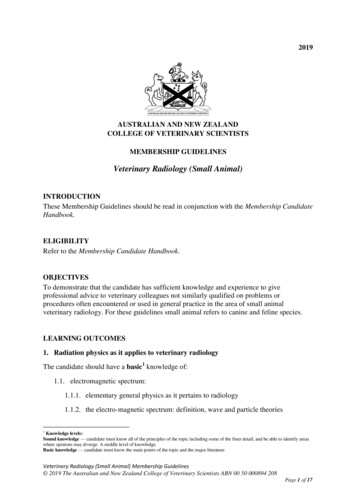
Transcription
2019AUSTRALIAN AND NEW ZEALANDCOLLEGE OF VETERINARY SCIENTISTSMEMBERSHIP GUIDELINESVeterinary Radiology (Small Animal)INTRODUCTIONThese Membership Guidelines should be read in conjunction with the Membership CandidateHandbook.ELIGIBILITYRefer to the Membership Candidate Handbook.OBJECTIVESTo demonstrate that the candidate has sufficient knowledge and experience to giveprofessional advice to veterinary colleagues not similarly qualified on problems orprocedures often encountered or used in general practice in the area of small animalveterinary radiology. For these guidelines small animal refers to canine and feline species.LEARNING OUTCOMES1. Radiation physics as it applies to veterinary radiologyThe candidate should have a basic1 knowledge of:1.1. electromagnetic spectrum:1.1.1. elementary general physics as it pertains to radiology1.1.2. the electro-magnetic spectrum: definition, wave and particle theories1Knowledge levels:Sound knowledge — candidate must know all of the principles of the topic including some of the finer detail, and be able to identify areaswhere opinions may diverge. A middle level of knowledge.Basic knowledge — candidate must know the main points of the topic and the major literatureVeterinary Radiology (Small Animal) Membership Guidelines 2019 The Australian and New Zealand College of Veterinary Scientists ABN 00 50 000894 208Page 1 of 17
1.2. generation of x-ray photons:1.2.1. components of the x-ray tube, types of anodes: rotating and stationary, cathode1.2.2. thermionic emission, line focus principle, heel effect, heat dissipation,structure of the atom, binding forces1.2.3. basic generator circuits, rectification, transformers, capacitor dischargeequipment1.3. production of the x-ray photon:1.3.1. interactions at the anode: general radiation / Bremsstrahlung and characteristicradiation1.3.2. the effect of kV, mA and time on x-ray photon production1.4. the interaction of x-ray photons with matter:1.4.1. coherent scatter, the photoelectric effect, Compton and the relative frequenciesof these interactions1.4.2. factors affecting attenuation / the inverse square law1.4.3. scatter radiation – factors affecting the production of and methods to reducethe effects of scatter - grids (types, cut-off), air gap techniques, beamcollimation1.4.4. formation of an image due to differential x-ray absorption1.5. factors affecting image quality:1.5.1. density, contrast, sharpness1.5.2. the origin and control of scatter:1.5.2.1. control of scatter production1.5.2.2. reduction of the negative impact of scatter on image quality1.5.3. unsharpness:1.5.3.1. geometric (magnification, distortion, penumbra effect)1.5.3.2. motion2. Practice of veterinary radiographyThe candidate should have a basic knowledge of:2.1. practical radiography:2.1.1. exposure assessment in digital radiography2.1.2. factors influencing the choice of kV, mA, time, and gridsVeterinary Radiology (Small Animal) Membership Guidelines 2019 The Australian and New Zealand College of Veterinary Scientists ABN 00 50 000894 208Page 2 of 17
2.1.3. formation of a technique chart2.1.4. patient positioning and problems in veterinary practice/limitations2.1.5. the need for restraint and suitable methods/advantages and disadvantages ofanaesthesia2.2. radiographic anatomy of the appendicular and axial skeleton, thorax and abdomenof dogs and cats2.3. radiographic projections of the different regions of the axial and appendicularskeleton, thorax and abdomen of dogs and cats3. Digital RadiographyDigital radiography encompasses both computed radiography and direct digital systems.The candidate should have a basic knowledge of:3.1. differences in image formation between computed radiography and direct digitalsystems (both direct and indirect direct digital systems)3.2. advantages and disadvantages of types of digital radiography including but notlimited to latitude, exposure, speed, mobility, portability, workflow.3.3. principles of:3.3.1. digital imaging and communication in medicine (DICOM)3.3.2. picture archiving and communications systems (PACS)3.4. common artefacts associated with digital radiography including but not restricted tostorage scatter, cracks of imaging plate, phantom image, quantum mottle, planking,grid cut-off, Moire, double exposure, dead pixels, dirty light guide, faulty datatransfer, Uberschwinger, clipping/image saturation3.5. factors affecting image quality specific to digital imaging (including systemresolution, exposure index, use of grids, algorithms, look-up table)4. Diagnostic ultrasoundThe candidate should have a sound knowledge of:4.1. generation of the ultrasound image4.2. production of ultrasound – transducer, piezoelectric crystal, frequency, pulserepetition frequency (PRF), power, focal zone4.3. interactions of sound within the patient – acoustic impedance, transmission,absorption, reflection, refraction, scatter4.4. processing the returning signal to generate an image - gain, time gain compensation(TGC), dynamic range.Veterinary Radiology (Small Animal) Membership Guidelines 2019 The Australian and New Zealand College of Veterinary Scientists ABN 00 50 000894 208Page 3 of 17
4.5. factors that influence ultrasound image quality, including but not limited to:4.5.1. resolution – spatial resolution (axial, lateral, and slicethickness/elevational), and temporal resolution4.5.2. artefacts4.6. functions of the ultrasound machine used in image optimisation, including but notlimited to depth, focal one, gain, time gain compensation (TGC), dynamic range,persistence/frame averaging5. Radiation safetyThe candidate should have a sound knowledge of:5.1. Code of Practice and Legislation:5.1.1. radiation monitoring, safety equipment and regulations5.1.2. relevant Australian and New Zealand laws and Codes of Practice asthey apply to the use of ionising radiation5.2. biologic effects of radiation:5.2.1. direct and indirect effects5.2.2. stochastic and deterministic effects5.3. practical applications of the principles of radiation safety, including:5.3.1. practical applications of a Radiation Management Plan (Australia) orRadiation Safety Plan (New Zealand)5.3.2. principles of radiation protection: risks involved in the use ofradiographic procedures/methods to minimise this risk5.3.3. basic radiation protection rules for a small animal practice5.3.4. maximum permissable dose (MPD)5.3.5. the ALARA principle (As Low As Reasonably Achievable)5.4. monitoring radiation exposure:5.4.1. units of dose and exposure: Gray, Sievert.5.4.2. devices, monitoring bodies6. Other imagingThe candidate should have a basic knowledge of:6.1. production of a computed tomography (CT) and magnetic resonance imaging (MRI)imageVeterinary Radiology (Small Animal) Membership Guidelines 2019 The Australian and New Zealand College of Veterinary Scientists ABN 00 50 000894 208Page 4 of 17
6.2. clinical applications of computed tomography (CT) and magnetic resonanceimaging (MRI) in veterinary practice.7. Contrast agents and radiographic contrast procedures (contrast studies)The candidate will be able to with sound2 expertise:7.1. describe how common radiographic contrast procedures in dogs and cats of thegastrointestinal system are performed: oesophagram, upper gastrointestinal bariumseries, colonogram7.2. describe how common radiographic contrast procedures on dogs and cats of theurinary system are performed: excretory urogram, retrograde cystogram (positive,negative, double contrast), retrograde urethrogram and vaginourethrogram.The candidate should have a sound knowledge of:7.3. Barium sulphate in its different formulations7.4. Iodinated contrast agents and its formulations including the difference betweenionic and non-ionic formations.The candidate should have a basic knowledge of:7.5. the pharmacology of radiographic contrast agents including: mechanism of action,indications, contraindication, common side effects and dose rates7.6. the myelographic procedure.8. General radiological interpretation of dogs and catsThe candidate will have a sound knowledge of:8.1. radiographic appearance of the normal structure and function of the various organsystems investigated in small animal practice8.2. radiographic pathology, and associated pathophysiology, of the various organsystems commonly investigated in small animal practiceThe candidate will be able to with sound expertise:8.3. demonstrate a systematic approach to radiographic interpretation8.4. determine which radiographic projection is presented from the radiographicanatomy8.5. recognise, describe and interpret (including formulation of ranked order list ofdifferential diagnoses for) radiographic and sonographic abnormalities in dogs andcats2Skill levels:Sound expertise – the candidate must be able to perform the technique with a moderate degree of skill, and have moderate experience in itsapplication. A middle level of proficiency.Basic expertise – the candidate must be able to perform the technique competently in uncomplicated circumstancesVeterinary Radiology (Small Animal) Membership Guidelines 2019 The Australian and New Zealand College of Veterinary Scientists ABN 00 50 000894 208Page 5 of 17
8.6. select and interpret an appropriate imaging modality (radiography or ultrasound)The candidate should have a sound knowledge of:8.7. normal sonographic appearance of the following structures in the dog and cat:8.7.1. abdomen - liver, spleen, kidneys, adrenal glands, urinary bladder,gastrointestinal tract, pancreas, peritoneal cavity, male and femalereproductive tract8.7.2. thorax – heart, pulmonary-pleural interface, cranial mediastinum9. Skeletal abnormalities9.1. General principlesThe candidate will have a sound knowledge of:9.1.1. reaction of bone to disease:9.1.1.1. bone lysis patterns (geographic, moth-eaten, permeative)9.1.1.2. periosteal and endosteal new bone patterns9.1.2. classification of fractures:9.1.2.1. descriptors of fracture type (e.g. spiral, transverse,incomplete/complete, comminution etc.)9.1.2.2. location9.1.2.3. Salter-Harris types9.1.3. bone healing:9.1.3.1. radiographic signs of bone healing: primary and secondaryintention bone healing9.1.3.2. radiographic signs of complications of bone healing: delayedunion, malunion, non-union9.1.4. osteoarthritis:9.1.4.1. radiographic signs of septic and degenerative osteoarthritis9.1.4.2. radiographic signs of osteoarthritis in all joints, but in particularthe shoulder, elbow, carpus, coxofemoral, stifle and hock jointsThe candidate will be able to, with sound expertise:9.1.5. classify bony lesions in the spectrum of benign or aggressive9.1.6. identify changes in soft tissues adjacent to bony lesions (for example jointeffusion or soft tissue mass)Veterinary Radiology (Small Animal) Membership Guidelines 2019 The Australian and New Zealand College of Veterinary Scientists ABN 00 50 000894 208Page 6 of 17
9.2. Juvenile bone diseaseThe candidate will have a sound knowledge of:9.2.1. osteochondrosis:9.2.1.1. common signalment in dogs9.2.1.2. radiographic signs including common locations.9.2.2. hip dysplasia:9.2.2.1. hip dysplasia schemes available in Australia and New Zealand9.2.2.2. the method of obtaining studies for each hip dysplasia scheme9.2.2.3. advantages and disadvantages of the Australian VeterinaryAssociation (AVA) scheme and the PennHIP scheme9.2.3. elbow dysplasia:9.2.3.1. types of elbow dysplasia in the dog: osteochondrosis, un-unitedanconeal process, medial coronoid process disease, elbowincongruity9.2.3.2. radiographic signs of types of elbow dysplasia in the dog9.2.3.3. radiographic signs of osteoarthritis in the elbowThe candidate will have a basic knowledge of:9.2.3.4. breeds at greatest risk of elbow dysplasia9.2.3.5. elbow dysplasia schemes available in Australia and NewZealand9.2.3.6. application of other diagnostic tools in the investigation anddiagnosis of elbow dysplasia (including CT scanning andarthroscopy)The candidate will have a sound knowledge of:9.2.4. radiographic signs of nutritional secondary hyperparathyroidism9.2.5. radiographic signs of panosteitis9.2.6. radiographic signs of hypertrophic osteodystrophy (syn. metaphysealosteopathy)Veterinary Radiology (Small Animal) Membership Guidelines 2019 The Australian and New Zealand College of Veterinary Scientists ABN 00 50 000894 208Page 7 of 17
9.3. VertebraeThe candidate will have a sound knowledge of:9.3.1. the radiographic signs and clinical significance of congenital vertebralanomalies9.3.2. the radiographic signs of spinal disease in dogs and cats, including but notlimited to intervertebral disc disease, atlanto-axial instability, canine cervicalspondylomyelopathy, discospondylitis.The candidate will have a basic knowledge of:9.3.3. the use of myelography in the investigation of spinal disease in dogs and cats9.3.4. indications for advanced spinal imaging (including myelography, CT andMRI)9.4. HeadThe candidate will have a sound knowledge of:9.4.1. the radiographic signs of nasal cavity disease, including neoplasia and rhinitis(fungal, other infectious, foreign body, allergic, lymphoplasmacytic)9.4.2. the radiographic signs of and differential diagnoses for bony neoplasia of thehead9.4.3. the radiographic signs of otitis media9.4.4. the radiographic signs of periodontal diseaseThe candidate will have a basic knowledge of:9.4.5. the radiographic signs of temporomandibular joint disease9.4.6. the radiographic signs of parathyroid disease9.4.7. the indications for CT and MRI of the head10. Thorax abnormalities10.1. Heart and pulmonary vesselsThe candidate will have a sound knowledge of:10.1.1. radiographic cardiac anatomy (for example, using cardiac clock-face analogy),including the anatomy of pulmonary lobar vessels and differentiation ofpulmonary arteries and veins10.1.2. sonographic cardiac anatomy as seen in the right parasternal long axis andshort axis views10.1.3. radiographic signs of cardiomegaly, including means to quantify these signsVeterinary Radiology (Small Animal) Membership Guidelines 2019 The Australian and New Zealand College of Veterinary Scientists ABN 00 50 000894 208Page 8 of 17
10.1.4. radiographic signs of left and right chamber enlargement and left and rightsided heart failure10.1.5. differential diagnoses for cardiomegaly, especially as they apply to differentspecies and breeds10.2. LungsThe candidate will have a sound knowledge of:10.2.1. radiographic anatomy of the canine and feline lung10.2.2. radiographic classification of pulmonary disease:10.2.2.1. traditional paradigms of lung pattern (alveolar, bronchial,interstitial patterns)10.2.2.2. distribution paradigm (cranioventral, caudodorsal, bilateral,unilateral, diffuse)10.3. Pleural spaceThe candidate will have a sound knowledge of:10.3.1. radiographic anatomy of the pleural space10.3.2. radiographic signs of pleural space disease, including differential diagnoses forthese diseases10.4. Mediastinum/body wall/diaphragmThe candidate will have a sound knowledge of:10.4.1. radiographic anatomy of the mediastinum, including the organs located in eachregion (cranial, mid, and caudal mediastinum).10.4.2. radiographic signs of abnormalities of the mediastinum, particularly diseasesof the trachea, oesophagus, lymph nodes, thymus10.4.3. indications for an oesophagram10.4.4. the methods of performing an oesophagram, including the contrast agents10.4.5. radiographic anatomy of the body wall10.4.6. radiographic signs of diseases of the ribs10.4.7. radiographic features of conditions affecting the diaphragm.Veterinary Radiology (Small Animal) Membership Guidelines 2019 The Australian and New Zealand College of Veterinary Scientists ABN 00 50 000894 208Page 9 of 17
10.5. Thoracic ultrasoundThe candidate will have a sound knowledge of:10.5.1. ‘Thoracic Focused Assessment with Sonology for Trauma, Triage andTracking’ (TFAST3) ultrasound examination.11. Abdomen (including peritoneal and retroperitoneal space) abnormalities11.1. Gastrointestinal tractThe candidate will have a sound knowledge of:11.1.1. radiographic anatomy of the gastrointestinal tract, including the differinglocation of small and large bowel11.1.2. the variable radiographic appearance of the intestine in dogs and in cats11.1.3. radiographic signs of and differential diagnoses for diseases of thegastrointestinal tract, including but not limited to gastric dilatation andvolvulus, and small intestinal obstruction.11.1.4. indications for gastrointestinal contrast studies11.1.5. indications for gastrointestinal ultrasoundThe candidate will have a basic knowledge of:11.1.6. sonographic signs of small intestinal obstruction11.2. PancreasThe candidate will have a sound knowledge of:11.2.1. the radiographic signs of and differential diagnoses for diseases of thepancreasThe candidate will have a basic knowledge of:11.2.2. the sonographic signs of pancreatitis11.3. Hepatobiliary systemThe candidate will have a sound knowledge of:11.3.1. radiographic signs of and differential diagnoses for hepatobiliary disease,including but not limited to those that cause hepatomegaly (focal orgeneralised), reduction in liver size, and alterations to liver opacity(mineralisation, gas)Veterinary Radiology (Small Animal) Membership Guidelines 2019 The Australian and New Zealand College of Veterinary Scientists ABN 00 50 000894 208Page 10 of 17
The candidate will have a basic knowledge of:11.3.2. sonographic signs of and differential diagnoses for hepatic disease includingbut not limited to nodular hyperplasia, hyperadrenocorticism, diabetesmellitus, diffuse and focal neoplasia, hepatitis, abscess, cirrhosis, congestion11.4. SpleenThe candidate will have a sound knowledge of:11.4.1. radiographic signs of and differential diagnoses for splenic disease such assplenomegaly, splenic mass lesionsThe candidate will have a basic knowledge of:11.4.2. sonographic signs of and differential diagnoses for splenic disease, includingbut limited to lymphoid hyperplasia (nodular hyperplasia), extramedullaryhaematopoiesis, diffuse and focal neoplasia, splenitis, congestion, abscess,myelolipoma11.5. Adrenal glandsThe candidate will have a sound knowledge of:11.5.1. normal retroperitoneal anatomy11.5.2. radiographic signs of and differential diagnoses for adrenal disease such asadrenomegaly or mineralisationThe candidate will have a basic knowledge of:11.5.3. sonographic signs of and differential diagnoses for adrenal disease such asadrenomegaly11.6. Urinary tractThe candidate will have a sound knowledge of:11.6.1. normal radiographic anatomy (including size) of the urinary tract (kidneys,ureters, urinary bladder, urethra (male and female)11.6.2. radiographic signs of and differential diagnoses for urinary tract disease suchas renomegaly, alterations in radiographic opacity within the urinary tract11.6.3. indications and techniques for urinary contrast studiesVeterinary Radiology (Small Animal) Membership Guidelines 2019 The Australian and New Zealand College of Veterinary Scientists ABN 00 50 000894 208Page 11 of 17
The candidate will have a basic knowledge of:11.6.4. sonographic appearance of renal disease such as acute kidney injury, chronicrenal disease, neoplasia, obstruction11.6.5. sonographic appearance of cystitis, cystolithiasis, and neoplasia of the urinarybladder11.6.6. contraindications for urinary contrast studies11.7. Reproductive tractThe candidate will have a sound knowledge of:11.7.1. Normal radiographic anatomy of the prostate, testes, ovaries, uterus andvagina11.7.2. radiographic signs of and differential diagnoses for reproductive tract diseasesuch as prostatomegaly, uterine enlargementThe candidate will have a basic knowledge of:11.7.3. sonographic appearance of pyometra, benign prostatic hyperplasia11.7.4. radiographic detection of pregnancy11.7.5. the use of ultrasound in pregnancy diagnosisVeterinary Radiology (Small Animal) Membership Guidelines 2019 The Australian and New Zealand College of Veterinary Scientists ABN 00 50 000894 208Page 12 of 17
EXAMINATIONSFor information on both the standard and format of the Written and Practical/Oralexaminations, candidates are referred to the Membership Candidate Handbook. TheMembership examination has two separate components:1.Written Papers (Component 1)Written paper 1: Principles of Small Animal Imaging (two hours)Written paper 2: Applied Aspects of Small Animal Imaging (two hours)2.Practical and Oral Examination (Component 2)Practical (two hours forty minutes)Oral (one hour)The written examination will comprise two separate two-hour written papers taken on thesame day. There will be an additional 15 minutes perusal time for each paper, during whichno writing in an answer booklet is permitted. There is no choice of questions. Marks allocatedto each question and to each subsection of questions will be clearly indicated on the writtenpaper.Each two hour written examination will comprise:Two (2) essay-type questions of 30 marks each. Questions may be broken into multiplesub-parts. TOTAL SUGGESTED TIME: 60 minutesFour (4) short-answer questions 10 marks each TOTAL SUGGESTED TIME: 40 minutesTen (10) multiple choice questions 2 marks each TOTAL SUGGESTED TIME: 20minutesWritten Paper 1:This paper is designed to test the Candidate’s knowledge of the principles of VeterinaryRadiology as described in the Learning Outcomes. Answers may cite specific exampleswhere general principles apply, but should primarily address the theoretical bases underlyingeach example. Written Paper 1 will mainly cover the Learning Outcomes 1-7, howevermaterial from any learning outcome may be examined. The species examined will be canineand feline.Written Paper 2:This paper is designed to (a) test the Candidate’s ability to apply the principles of VeterinaryRadiology to particular cases/problems or tasks and (b) test the Candidate’s familiarity withthe current practices and current issues that arise from activities within the discipline ofVeterinary Radiology in Australia and New Zealand. Written Paper 2 will mainly cover theLearning Outcomes 8-11, however material from any Learning Outcome may be examined.The species examined will be canine and feline.Veterinary Radiology (Small Animal) Membership Guidelines 2019 The Australian and New Zealand College of Veterinary Scientists ABN 00 50 000894 208Page 13 of 17
Practical Examination:The practical examination will be 160 minutes in duration and will require written reports onthe radiographic digital images of eight (8) cases. Images will be provided in Power Point;no image manipulation will be required. Ultrasound images or clips may be included. Totalsuggested time for each case is twenty (20) minutes; however candidates are free to movethrough the cases at their own pace. Each case is of equal value, 20 marks each, equating to atotal of 160 marks. The species examined will be canine and feline.Each answer might include the following: description of the study i.e. list of included views and any techniques used (i.e.contrast studies) radiographic description conclusions or interpretation, including a ranked differential diagnosis list recommendations of further imaging techniques if appropriateThe practical examination may not necessarily be limited to these types of questions.Examiners are looking for a systematic evaluation of the study. Marks will be awardedfor the following areas: correct identification of radiographic views assessment of radiographic quality only where it impacts interpretation ofthe image description of imaging abnormalities radiographic conclusions and differential diagnoses recommendations for further imaging proceduresThe candidates must demonstrate to the examiners their thought processes, prioritisation andconclusions.Normal findings need not be described in detail, but the candidate should indicate they havebeen evaluated and are normal (for example: ‘there are no skeletal abnormalities’).Candidates should not comment on artefacts unless they are pertinent to interpretation of thestudy (i.e. they affect the study outcome).Both descriptive sentences and dot points may be used for the observation of imagingabnormalities or conclusions.Candidates must use correct radiographic terminology and avoid colloquial language.Oral Examination:This examination will be approximately one (1) hour duration and will include descriptionand interpretation of digital images (both radiograph and ultrasound). Six (6) cases arepresented with supporting questions asked verbally in a face-to-face setting. The oralexamination has a total of 120 marks with each case allocated 20 marks.Images will be provided in Power Point format.Cases and questions aim to test how the candidate arrives at their radiographic conclusions.Candidates may request additional imaging studies, these may or may not be available.The candidates must demonstrate to the examiners their thought processes, prioritisation andconclusions.Veterinary Radiology (Small Animal) Membership Guidelines 2019 The Australian and New Zealand College of Veterinary Scientists ABN 00 50 000894 208Page 14 of 17
Marks will be awarded for: demonstration of a systematic approach the candidate's description of imaging abnormalities the candidate’s ability to draw logical conclusions from the imagingfindings the candidate's ability to make appropriate patient managementrecommendations, including both imaging-related diagnostics and otherpertinent diagnostic testing.Candidates should not comment on artefacts unless they are pertinent to interpretation of thestudy. Normal findings need not be described in detail, but the candidate should indicatethey have been evaluated and are normal (for example: ‘there are no skeletalabnormalities’).Examples of questions:“Describe the artefact you see and discuss how this occurred”An image depicting a brand of contrast medium. “What is this chemical? What are theindications and contraindications for its use?”A lateral and ventrodorsal projection of a young dog’s abdomen depicting a smallintestinal obstruction. The candidate must be able to identify and describe all of theradiographic features present that are consistent with a small intestinal obstruction. Thecandidate must be able to draw a logical conclusion (e.g. mechanical small intestinalileus), formulate a differential diagnosis list appropriate to the history and signalmentof the patient (e.g. foreign body, intussusception etc.), and make appropriate patientmanagement recommendations (e.g. exploratory laparotomy).An ultrasound clip of a urinary bladder of a cat with haematuria. The clip shows acystolith. The candidate must be able to describe the sonographic findings that wouldlead to this conclusion (e.g. a dependent shadowing intraluminal object). The candidateshould make appropriate recommendations (e.g. cyctocentesis and urinalysis).Veterinary Radiology (Small Animal) Membership Guidelines 2019 The Australian and New Zealand College of Veterinary Scientists ABN 00 50 000894 208Page 15 of 17
RECOMMENDED READING LISTThe candidate is expected to read widely within the discipline, paying particular attention toareas not part of their normal work experiences. This list of books and journals is intended toguide the candidate to some core references, including comparative texts, and other sourcematerial. Candidates also should be guided by their mentor / supervisor. The list is notcomprehensive and is not intended as an indicator of the content of the examination.Recommended textbooks:3Thrall DE. (2017) 7th ed. “Textbook of Veterinary Radiology”, Saunders Elsevier, Missouri.Nyland TG, and Mattoon JS. (2015) 3rd ed. “Small Animal Diagnostic Ultrasound”,Saunders Elsevier, PhiladelphiaPenninck D, and d’Anjou MA. (2015) 2nd ed. “Atlas of Small Animal Ultrasonography”,Blackwell PublishingAdditional reading materials:Barr FJ, and Kirberger RM. (2006) “BSAVA Manual of Canine and Feline MusculoskeletalImaging” BSAVABushong SC. (2012) 10th ed. “Radiologic Science for Technologists: Physics, Biology, andProtection” ElsevierMuhlbauer MC, and Kneller SK. (2013) “Radiography of the dog and cat: guide to makingand interpreting radiographs”, Wiley-BlackwellO’Brien R, and Barr FJ. (2009) “BSAVA Manual of Canine and Feline AbdominalImaging” BSAVASchwarz T, and Johnson V. (2008) “BSAVA Manual of Canine and Feline ThoracicImaging” BSAVACoulson A and Lewis N. (2008) “An Atlas of Interpretative Radiographic Anatomy of theDog & Cat”, 2nd ed, Blackwell Science, OxfordThrall D, Robertson I. (2015) “Atlas of normal radiographic anatomy and anatomic variantsin the dog and cat”, 2nd ed., Saunders.Lavin LM. (2014) “Radiography in Veterinary Technology”, 5th ed. Saunders Elsevier,Philadelphia.Wallack ST. (2003) “The Handbook of Veterinary Contrast Radiography” San DiegoImaging Inc. CA, USADennis R, Kirberger RM, Barr FB, Wrigley RH. (2010) “Handbook of Small AnimalRadiological Differential Diagnoses” 2nd ed. Elsevier Health Sciences.3Definitions of TextbooksRecommended textbook – candidates should own or have ready access to a copy of the book and have a sound knowledge of the contents.Additional references – candidates should have access to the book and have a basic knowledge of the contents.Veterinary Radiology (Small Animal) Membership Guidelines 2019 The Australian and New Zealand College of Veterinary Scientists ABN 00 50 000894 208Page 16 of 17
Lisciandro GR. (2014) “Focused Ultrasound Techniques for the Small Animal Practitioner”.Wiley Blackwell.Nykamp SG, et al. “Radiographic signs of pulmonary disease: An alternative approach”Compendium on Continuing Education for the Practicing Veterinarian, 2002; 24(1):25-36 *this is the first description of the “location approach” to reading thoracic radiographs and isan excellent description of this approach to the interpretation of thoracic radiographsVeterinary Radiology and Ultrasound : 2008; 49 (supplement 1) – digital radiography.Mattoon JS. “Digital Radiography” Vet Comp Ort
5.3.1. practical applications of a Radiation Management Plan (Australia) or Radiation Safety Plan (New Zealand) 5.3.2. principles of radiation protection: risks involved in the use of radiographic procedures/methods to minimise this risk 5.3.3. basic radiation protection rules for a small animal practice 5.3.4. maximum permissable dose (MPD) 5.3.5.
